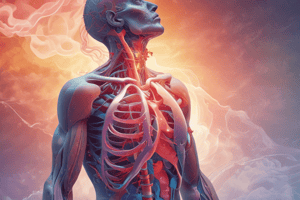Podcast
Questions and Answers
What does the cardiovascular system consist of?
What does the cardiovascular system consist of?
- Muscles and tissues
- Heart and blood vessels (correct)
- Blood and nutrients
- Lungs and air passages
The cardiovascular system is also known as the circulatory system.
The cardiovascular system is also known as the circulatory system.
True (A)
What is the main function of the cardiovascular system?
What is the main function of the cardiovascular system?
To deliver nutrients and oxygen to cells and remove waste and carbon dioxide.
What are the main components of blood?
What are the main components of blood?
How many liters of blood does a person have on average?
How many liters of blood does a person have on average?
The smallest blood vessels, where nutrient and gas exchange occurs, are called ______.
The smallest blood vessels, where nutrient and gas exchange occurs, are called ______.
What color is oxygenated blood as it leaves the heart?
What color is oxygenated blood as it leaves the heart?
Veins carry oxygenated blood away from the heart.
Veins carry oxygenated blood away from the heart.
What is the role of platelets in blood?
What is the role of platelets in blood?
The major artery that leaves the heart is called the ______.
The major artery that leaves the heart is called the ______.
Match the following blood vessels with their respective functions:
Match the following blood vessels with their respective functions:
Flashcards are hidden until you start studying
Study Notes
Cardio-Respiratory System
- The cardiovascular system includes the heart and blood vessels
- The respiratory system includes the lungs and air passages
- The two systems work together, hence the name Cardio-Respiratory system.
Functions of the Cardiovascular System
- Delivers nutrients and oxygen to cells
- Removes waste and carbon dioxide from cells
- Maintains a constant core body temperature of 37°C
Blood
- The fluid that flows through the circulatory system
- Contains blood cells, food, minerals, and gases vital for the body's function
- An average person has 4-5 liters of blood, which circulates around the body in 20 seconds.
- Composed of 45% blood cells and 55% plasma.
Blood Functions
- Transports oxygen from the lungs to tissues
- Transports carbon dioxide from tissues to the lungs
- Transports waste from tissues to the kidneys
- Transports digested food from the small intestine to tissues
Blood Components
- Red blood cells: Contain haemoglobin that carries oxygen in the blood.
- White blood cells: Fight infections in the body.
- Platelets: Cells that form blood clots to stop bleeding.
- Blood plasma: 90% water, the fluid that carries all the cells and nutrients.
Blood Vessels
- Network of veins and arteries that carry blood throughout the body
- Largest blood vessels are closest to the heart and get smaller as they move toward the body's outer surfaces.
- Humans have approximately 100,000 km of blood vessels, enough to wrap around Earth 2.5 times.
Types of Blood Vessels
- Arteries: Carry blood away from the heart, have strong elastic walls, contain a pulse, and carry bright red oxygenated blood.
- Arterioles: Smaller arteries that turn into capillaries
- Capillaries: Vast network throughout body tissues, very small with thin walls, allow nutrients and oxygen into tissues and collect carbon dioxide and waste.
- Venules: Very small veins that collect blood from capillaries.
- Veins: Carry blood back to the heart, carry dark reddish-blue deoxygenated blood, have thin walls, less elastic, and contain valves to prevent backflow.
- Capillaries link arteries to veins by allowing the exchange of nutrients, and oxygen into muscles, and carbon dioxide and waste to pass out.
Blood’s Journey
- Blood leaves the heart via the aorta, the body's main artery.
- Blood travels through arterioles after the main arteries.
- Blood moves through the capillary network to deliver oxygen and nutrients and collect carbon dioxide and waste.
- Blood then makes its way back to the heart via venules and veins.
Important Blood Vessels
- Aorta: The main artery of the body, the first artery blood enters when leaving the heart.
- Superior and Inferior Vena Cava: Return blood to the heart.
The Heart
- A hollow muscular structure made of cardiac muscle.
- A pump that pushes blood around the body.
- About the size of a fist.
Studying That Suits You
Use AI to generate personalized quizzes and flashcards to suit your learning preferences.




